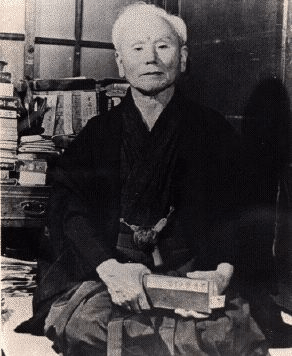Japan
In 1916 he gave a demonstration to the Butokuden in Kyoto, Japan, which at that time was the official center of all martial arts. On March 6, 1921, the Crown Prince, who was later to become the Emperor of Japan, visited Okinawa and Master Funakoshi was asked to demonstrate karate. In the early spring of 1922 Master Funakoshi traveled to Tokyo to present his art at the First National Athletic Exhibition in Tokyo organized by the Ministry of Education. He was strongly urged by several eminent groups and individuals to remain in Japan, and indeed he never did return to Okinawa.
Master Funakoshi taught only one method, a total discipline, which represented a synthesis of Okinawan karate styles. This method became known as Shotokan, literally the clan or the house of Shoto (which was the Master's pen name for his poetry and calligraphy). Shoto means waving pine. Funakoshi selected this name as a pen name because he enjoyed hearing the sound of the wind through the pine trees as he took evening walks in Okinawa.
In 1936, Funakoshi built his first dojo in Tokyo. His students named it the Shotokan, meaning Shoto's club. Funakoshi did not actually name his style of karate, but the name of the dojo came to be associated with the style itself.
Master Funakoshi died on 26 April 1957. During his lifetime, he trained many famous students, including Shigeru Egami, Masatoshi Nakayama, Keinosuke Enoeda, Tsutomu Oshima, Hidetaka Nishiyama and Teruyuki Okazaki.
Karate Styles
There are four major styles of Karate today: Shito-ryu, Goju-ryu, Shotokan-ryu, and Wado-ryu.
Shotokan-ryu, which was founded by Funakoshi, came from Shorin-ryu (from Shuri-te), and utilizes long linear stances and physical power. This style was one of the first styles to be introduced to Japan in the 1920's. Powerful kata such as Bassai (Shuri-te) are typical of this style.
Goju-ryu was founded by Miyagi. It came from Shorei-ryu (from Naha-te and Tomari-te), which utilize up and down stances and internal breathing power (known as "hard and soft" techniques). Kata such as Sanchin (Naha-te) and Rohai (Tomari-te) demonstrate these techniques well.
Shito-ryu was founded by Mabuni. It is a combination of Shorin-ryu and Shorei-ryu, which makes this style a lot like a combination of Goju-ryu and Shotokan-ryu. Shito-ryu is fast, but is still powerful and artistic. Its kata include the same kata as Shotokan-ryu and Goju-ryu, as well as some artistic Chinese white crane kata such as Nipaipo. Shito-ryu also practices with Kobudo (weapon arts) and sometimes Iaido (sword arts) as part of the style, which makes Shito-ryu fairly unique among the modern Karate styles.
Wado-ryu is a derivative of Shotokan-ryu. It was founded by Ohtsuka, a student of Funakoshi.
